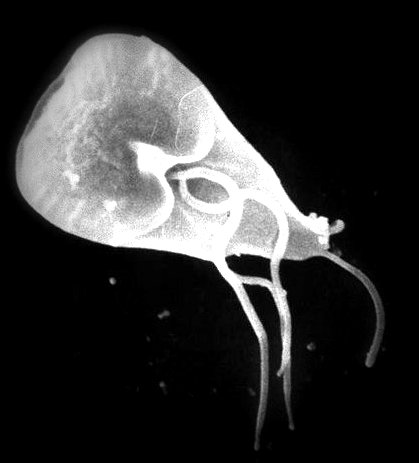
If you were to look at a single Giardia protozoa under a microscope this is what you would see Giardia is a tiny parasite, one-celled protozoa. They can be difficult to see under the microscope
Our 5 Pomeranians live in our home with us. When we have puppies , they have their own special room in our home . We call it the "Puppy Room" We live in Arizona and so of course we have Central Air Conditioning as do our Pomeranians and our Two Canaries ! LOL ........ and of course we do not have a kennel ,
Non the less I found this information about Giardia to be very interesting and so am "Sharing " it on my web site. Enjoy.....
Giardia
When it comes to Giardia in the kennel, the concer
n is less about treatment and more about the long term plan to manage it. Giardia is one of those parasites that always seems to be waiting for the perfect time to strike. In a kennel, this time is usually after weaning and right around the time the puppies get to their new home - both inconvenient times for a breeder.
Giardia is a tiny parasite, one-celled protozoa that is hard to diagnose. They can be difficult to see under the microscope and take a trained eye to identify them accurately. Screening tests are also available, called snap tests. In these tests, the feces is mixed with the solution, placed in a well and then "snapped" down to start the test, which checks for a protein from the Giardia organism. However, these tests are useful as a piece of the puzzle, not as a definitive test. Though negative tests are true negatives, false positives are very common and may be deceiving. If you have a positive snap test and you're not sure if it's correct, it may be helpful to send it to the lab for more accurate diagnosis.
Metronidazole has traditionally been used to treat Giardia, but lately there has been resistance - one study shows only 60% efficacy. The new treatment of choice is using Fenbendazole (96% effective) 6 days in a row. Bathing is also important. Giardia oocysts are directly infective, meaning the dog passes them in the stool and can immediately contract the disease if they ingest the giardia again. Bathe the dog with a good soap or shampoo on days 3 and 5 of treatment. Giardia is sticky and will stay on the hair coat, particularly the back legs, so concentrate on the back half of the body. If you don’t bathe them, they can just re-infect themselves while grooming, making your treatment
ineffective.
Since Giardia is stubborn, kennels should be scrubbed with a degreaser or a good detergent. Flaming the surface of the kennel is also effective, especially for contaminated walls in metal kennels. Simply pass the flame over the surface - you don’t need to melt anything or damage the equipment. The heat causes the Giardia cyst to pop and die.
Long-term control starts with the mother. When she is heavily pregnant, the stress will decrease her resistance to parasites. Using Fenbendazole three days in a row after day 50 of gestation will decrease the shedding of the Giardia organism and be helpful in preventing the transfer of parasites to the puppies. Bathing the mother before whelping is also helpful. Alternatively, some breeders will clip the hair on the back legs and belly to remove the oocysts the mom carries on her hair. Either technique is effective.
For puppies, deworming three days in a row with Fenbendazole at 6 weeks of age is also good prevention. This helps eliminate any Giardia that may have found their way in the baby and is enough to provide effective prevention.
With all parasites, you want to think long-term control. If you just treat the puppies without considering where the parasite is coming from, you'll eventually get resistance that overwhelms your medication. Every year you should have fewer and fewer parasite numbers in your kennel. Roundworms, hookworms, whipworms, coccidia and giardia should all be accounted for in your preventative program. If you have any questions about parasite control, feel free to give us a call!